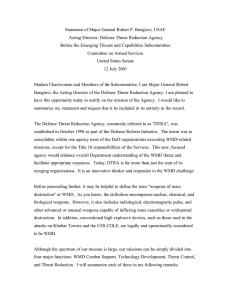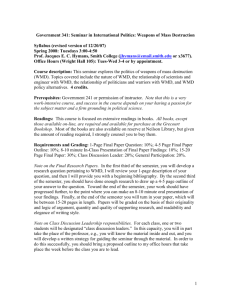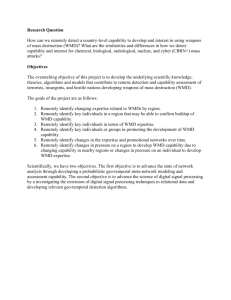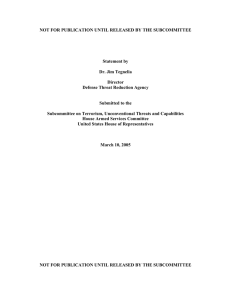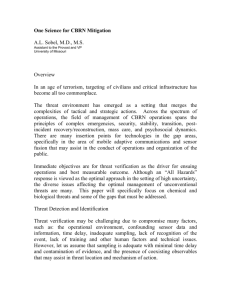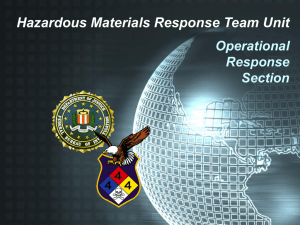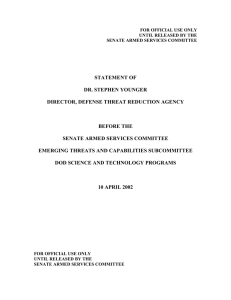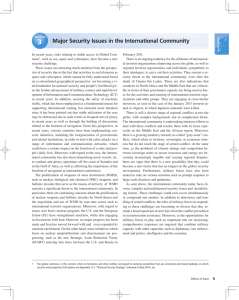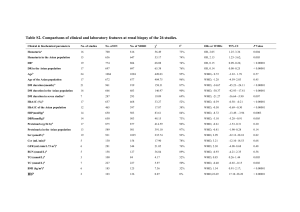THE HOUSE ARMED SERVICES COMMITTEE STATEMENT OF
advertisement
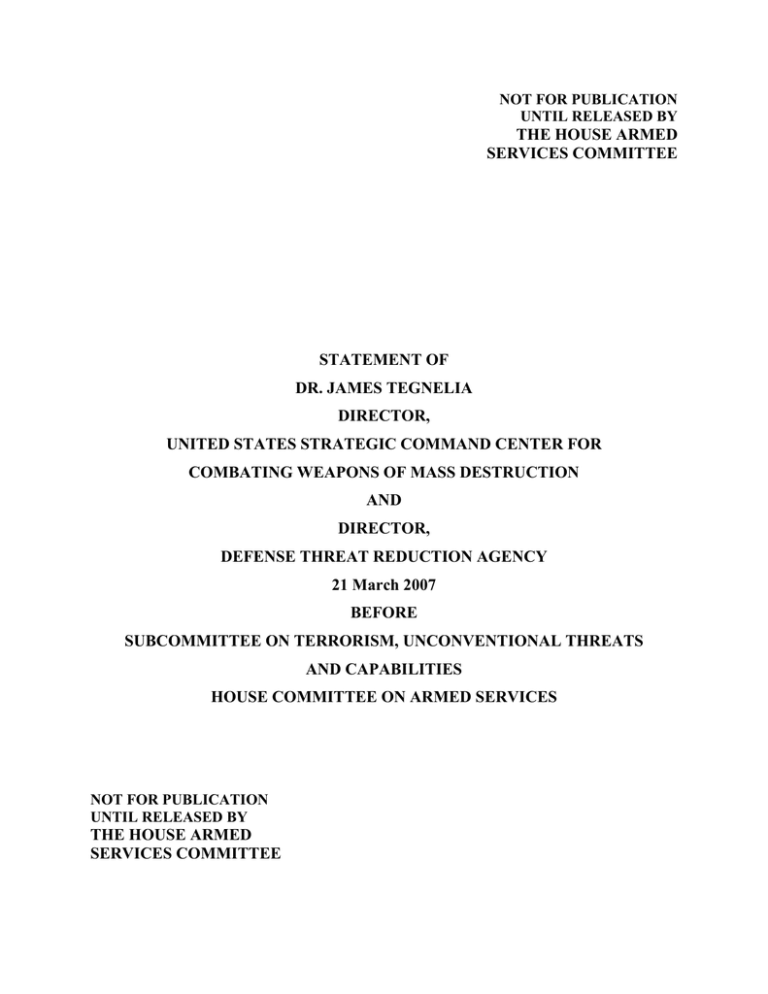
NOT FOR PUBLICATION UNTIL RELEASED BY THE HOUSE ARMED SERVICES COMMITTEE STATEMENT OF DR. JAMES TEGNELIA DIRECTOR, UNITED STATES STRATEGIC COMMAND CENTER FOR COMBATING WEAPONS OF MASS DESTRUCTION AND DIRECTOR, DEFENSE THREAT REDUCTION AGENCY 21 March 2007 BEFORE SUBCOMMITTEE ON TERRORISM, UNCONVENTIONAL THREATS AND CAPABILITIES HOUSE COMMITTEE ON ARMED SERVICES NOT FOR PUBLICATION UNTIL RELEASED BY THE HOUSE ARMED SERVICES COMMITTEE Introduction Mr. Chairman, it is an honor to be here today to address the mission of Combating Weapons of Mass Destruction or “WMD.” I will limit my remarks, but request that my entire statement be made part of the record. I serve concurrently as the Director of the Defense Threat Reduction Agency or “DTRA” and the Director of the United States Strategic Command Center for Combating WMD or the “SCC-WMD.” My statement reflects these dual responsibilities and will address the nature of the WMD threat; our response in terms of strategy, roles and responsibilities, and capabilities; and the unique contributions that the Commander, US Strategic Command and the Defense Threat Reduction Agency are making. Additionally, as you requested, I will also address the accomplishments of the Counterproliferation Program Review Committee, or “CPRC”. Lastly, since the DTRA mission is so broad and involves multiple appropriations accounts, I will also provide an overview of the Agency expressed in terms of campaigns that support national and DoD goals and capabilities. I believe that describing the Agency through the use of campaigns is the easiest way to quickly gain an appreciation for the Agency’s contribution and potential. The WMD Threat The threat of infectious diseases to warfighters and the civil population, and the use of poisons, toxins, and asphyxiating gases in war are not new threats. The Black Death of the 14th Century, for instance, killed at least 75 million and set back European society for generations. When George Washington sent his first contingent of troops into Boston after the British evacuation of that city, he chose men who had survived smallpox and were thus resistant to the disease. World War I was a chemist’s war, introducing massive numbers of chemical weapons on the battlefield. Artillery was the big killer, but roughly a quarter of all American battlefield casualties in that war were directly due to chemical agents. The 1918 influenza pandemic also killed millions. World War II was a 2 physicist’s war, introducing radar, ballistic missiles, the jet engine, and nuclear weapons. It was a technical competition that set the stage for the Cold War and the threat of nuclear annihilation. That threat is much less likely today, but the threat of limited use of nuclear weapons remains. Many also fear that biological threats are the wave of the future as advances in life sciences progress at a stunning rate and as the forces of globalization make the prospects of a global pandemic of massive proportions frighteningly possible. Add to this modern radical terrorism and proliferation of Weapons of Mass Destruction (WMD) to regional powers hostile to American interests and it is fair to say that the world has never been at more risk to WMD, or the WMD-like effects of a global pandemic. Combating WMD (CWMD) is a uniquely challenging mission because the threats are of catastrophic proportions and are evolving rapidly. There are no simple solutions. National expertise is limited and must be nurtured. International partnerships are vital and must be expanded. The situational awareness needed for a global pandemic, for instance, overlaps with that needed to detect a major bioterrorist campaign. Significant knowledge, technology, and capability gaps exist in CWMD. Resources are finite and stretched thin. This is an area where the enemy has to win only once; we have to win every time. And time is not on our side. Strategy and Capabilities Transformation For obvious reasons, national guidance places a high priority on combating the threats posed by WMD. National strategy seeks to reduce, contain, and prevent the further proliferation of WMD; to counter the WMD challenge offensively and defensively where it is present; and to achieve the capability to operate through and recover from WMD attacks. Within the Department of Defense, the three pillars of Combating WMD - nonproliferation, counterproliferation, and consequence management - are supported through eight Military Mission areas: Security Cooperation and Partner Activities; Threat Reduction Cooperation; Interdiction; Elimination; Offensive Operations; Active Defense; Passive Defense; and WMD Consequence Management. 3 In recent years, the department has been shifting its focus from traditional warfighting capabilities and nuclear-centric deterrence to capabilities more responsive to the irregular, catastrophic, and disruptive threats that characterize warfare in the 21st century. The 2006 Quadrennial Defense Review (QDR), 2006 Strategic Planning Guidance, and other departmental guidance emphasize the need to defeat terrorist networks, defend the homeland in depth, prevent the acquisition and use of WMD, and shape choices of countries at strategic crossroads. From the perspective of CWMD, it is imperative that efforts in all these areas be integrated and synchronized to maximize the full national and international potential. Indeed, the key to successfully meeting the WMD threat is to harness all elements of government, academia, industry, and international partners into a single, coordinated effort. We are developing a streamlined, collaborative process that will lead to shared situational awareness, a common operating picture, rapid and accurate analyses and threat anticipation, a full range of improved capabilities, efficient use of resources, and timely, executable courses of action. We are on the path to achieving this, but much work remains to be done. We are approaching this with a sense of urgency and full commitment. Counterproliferation Program Review Committee (CPRC) DTRA provides support to the Office of the Assistant to the Secretary of Defense for Nuclear and Chemical and Biological Defense (ATSD (NCB)) for activities of the Counterproliferation Program Review Committee (CPRC). The CPRC was chartered by the 1994 National Defense Authorization Act (NDAA). A requirement, established initially with the 1995 NDAA, requires the Department of Defense (DoD), Department of Energy (DOE) and the Intelligence Community (IC) to report annually on technology capability development, requirements, priorities and funding for countering the proliferation of Weapons of Mass Destruction (WMD). CPRC activities have enabled information sharing among its member organizations for efficient and effective use of government resources for 4 counterproliferation technology capability development. The annual report has provided information on investments for capability developments for the upcoming fiscal year, requirements they support and remaining shortfalls in capabilities to guide future research and development (R&D) investment planning. The report addresses over 200 DoD, DOE, and Intelligence Community programs every year. Since the CPRC was established, much has happened in terms of technology and capabilities to address threats, capability needs for a changing world situation, and in government organizations contributing to WMD proliferation threat reduction. Over the last year, there were many R&D products delivered that will be in included in the May 2007 CPRC report. In the Passive Defense Area, developmental detection, protection, and decontamination systems have matured for delivery into the field. Specifically, the Automatic Chemical Agent Detection Alarm (ACADA) has gone into full rate production; the Joint Biological Agent Identification and Diagnostic System (JBAIDS) has achieved Initial Operating Capability with 64 systems delivered in Fiscal Year 2006 with additional systems planned for Fiscal Year 2007; 101 vehicle-based and 11 shipbased Joint Biological Point Detection Systems (JBPDS) were configured in Fiscal Year 2006; and we began fielding the Joint Biological Standoff Detection System (JBSDS), which detects aerosols at five kilometers and discriminates at one kilometer. In the Protection Area, the Joint Protective Air Crew Ensemble (JPACE) has entered full rate production, and the Joint Services General Purpose Marks (JSGPM) is to enter full rate production in the third quarter of Fiscal Year 2007. In the Offensive Area, recent accomplishments include accreditation of Version 6 of the Integrated Munitions Effects Assessment (IMEA) code for improved capabilities in holding tunnel facilities and hardened bunkers at risk; and advanced signal intercept and warning sensors achieved full rate production mode for use on attack and guided missile submarines. The CPRC has also encouraged the participation of non-members, including the Department of Homeland Security (DHS), Department of Health and Human Services 5 (DHHS), and the Environmental Protection Agency (EPA), in CPRC activities. In addition, the CPRC has worked to ensure proper representation from the Intelligence Community after the establishment of the Director for National Intelligence and resulting changes in responsibilities within the intelligence community. This need to bring other government organizations into counterproliferation planning and reporting activities highlights the fact that the current law does not include new organizations and new responsibilities important to counterproliferation activities. Additionally, the report requirement in the law does not cover the activities that have emerged relative to CWMD areas. In short, the existing law has been overtaken by events and the Department, with the approval of DOE and the Central Intelligence Agency (CIA), has met with committee staff to discuss alternatives. We have recommended that Congress consider the new organizations, relationships, and responsibilities that have emerged since 1994 including: the creation of the DHS and the transfer of related R&D programs from DOE to that new Department; the establishment of the Director of National Intelligence (DNI); and the stand-up of the National Counterproliferation Center (NCPC) and the National Counter Terrorism Center (NCTC). Within DoD, there have been significant changes relevant to CWMD responsibilities with the creation of the Assistant Secretary of Defense for Homeland Defense; the establishment of the US Northern Command (NORTHCOM) as a new regional Combatant Commander for the Continental United States; and the assignment of Commander, US Strategic Command (STRATCOM) as the lead Combatant Commander for the CWMD mission. We recommend that these also be taken into consideration. Any new legislation should also consider the many interagency activities that have been established to reduce the threat of WMD including: the National Proliferation and Arms Control Technology Working Group (NPAC/TWG) to share technology development information in support of nonproliferation and arms control agreements; and the Counterproliferation Technology Coordination Committee that assesses technology development activities across the US Government (USG) to identify capabilities and gaps in technology development programs. We believe that there are many overlapping 6 interagency activities that could be harmonized better through simplification of coordination activities and reporting processes and inclusion of all critical organizations in those efforts. Lastly, the Department believes that the current requirement for annual reports should be modified to require less frequent reporting (e.g., every two years) to allow the interagency process to focus more of its time on opportunities to strengthen the planning, execution and assessment activities (vice reporting). This also would strengthen synchronization with the RDT&E Reliance process. We believe that, with the increased communication between the two branches, a report every two years is sufficient to provide the comprehensive program details that Congress needs. USSTRATCOM Center for Combating WMD As the integrator of DoD’s global warfighting capabilities, the Commander of the US Strategic Command (USSTRATCOM), General James E. Cartwright, USMC, is the lead Combatant Commander for the DoD Combating WMD mission. He is responsible for integrating and synchronizing the Department’s CWMD efforts and for coordinating them with interagency partners. General Cartwright’s primary Combating WMD mission enabler is the US Strategic Command Center for Combating WMD or “SCC-WMD.” This center is the primary functional enabling capability for assisting USSTRATCOM in integrating and synchronizing combating WMD within both the DoD and the US Government (USG). More specifically, the SCC-WMD will anticipate potential WMD-related events that may necessitate a DoD, USG, and/or internationally coordinated response; develop courses of action through knowledgeable Joint Interagency Group integration and synchronization; reduce reaction time; assess USG and international capabilities; identify needs and requirements; and recommend solutions for integrating and synchronizing CWMD capabilities. In its supporting role, the SCC-WMD is developing the annexes for the global plan to integrate and synchronize planning for CWMD (Concept Plan 8099). 7 Additionally, the SCC-WMD is providing planning assistance to all combatant commands that are developing regional CWMD plans and updating their deliberate plans related to CWMD. The SCC-WMD is organized similar to a Joint Functional Component Command and is staffed by both USSTRATCOM and DTRA personnel. The center was established at DTRA to best leverage DTRA’s long-standing subject matter experts and experience, which spans all eight military mission areas. Although it is a relatively new organization and still growing toward its full potential, the SCC-WMD already has made several notable contributions. These include: Joint Elimination Coordination Element In response to a task from the 2006 QDR to expand the Army’s 20th Support Command’s capabilities to enable it to serve as a joint task force capable of rapid deployment to command and control WMD elimination and site exploitation missions by 2007, the SCC-WMD developed the Joint Elimination Coordination Element (JECE). The JECE provides joint planning and WMD subject matter experts specifically organized, trained, and equipped to support command and control of the WMD Elimination mission. In addition, the JECE supports day-to-day operational and tactical level CWMD elimination planning, training, and exercises with the Regional Combatant Commanders, the Services, and other USG organizations. Joint Integrating Concept The CWMD Joint Integrating Concept provides a common vision of Joint Force Commander CWMD operations 8-20 years in the future and will guide follow-on capabilities based assessments as well as force management, experimentation, and Science and Technology development decisions by CWMD capability providers and users. Proliferation Security Initiative and WMD Interdiction On December 16, 2006, the Commander, USSTRATCOM appointed the SCC-WMD as the USSTRATCOM lead for the WMD Interdiction mission and for the Proliferation Security Initiative (PSI). This 8 will enable the department to maximize the use of its limited assets and resources, and assist and support our foreign partners’ efforts to integrate and contribute meaningfully to the PSI. The SCC-WMD leverages the interrelationship among the USSTRATCOM Global Operations Center, SCC-WMD, the DTRA CWMD Operations Center, and other USSTRATCOM Joint Functional Component Commanders to increase support to regional Combatant Commanders in targeting and surveillance requirements for ships of interest during Maritime Interdiction Operations. Support is being provided to the training and equipping of foreign partners through programs such as the International Counterproliferation Program and the WMD Proliferation Prevention Initiative so that WMD and WMD components may be interdicted at borders. In addition to providing support to the interdiction planning and operations of regional combatant commanders, the SCC-WMD is developing and will codify processes for providing those commanders WMD-focused technical reachback support from DTRA. Lastly, the SCC-WMD has been an active participant in the National Counterproliferation Center’s CWMD planning and synchronization efforts, providing an operational perspective to this intelligence focused group as well as leading USSTRATCOM participation in DOD PSI activities. Defense Threat Reduction Agency DTRA is the only DoD organization with a dedicated, fulltime, and integrated CWMD focus. It is home to DoD’s leading edge scientific, operational, and intellectual WMD expertise in nonproliferation, counterproliferation, and consequence management for Combatant Commands, the Services, and other DoD and US Government organizations. DTRA is also a “Combat Support Agency” tasked with providing Combating WMD solutions to the Joint Chiefs of Staff and Combatant Commanders, the Office of the Secretary of Defense, and other US Government agencies. DTRA has been designated as the primary combat support agency for the US Strategic Command in its efforts to integrate and synchronize CWMD efforts for the department. While the Agency has multiple operational “bosses,” it reports administratively to the Under 9 Secretary of Defense (Acquisition, Technology, and Logistics) through the Assistant to the Secretary of Defense for Nuclear and Chemical and Biological Defense Programs. Although the Agency was created in October 1998, it has a legacy through predecessor agencies and programs. On the nuclear side, that legacy dates to the Manhattan Project of World War II that developed the first atomic bomb. Additional expertise in non-nuclear weapons effects, particularly against hardened and deeply buried targets, and force protection was developed. On the chemical and biological side, the defensive Science and Technology (S&T) program and the operational concepts have been under development since the First World War. The Agency operates in a network of international networks and institutions that grew from a nuclear-centric focus during the Cold War to full-scope WMD coverage today. Cooperative threat reduction programs have also become important tools for CWMD. Today, DTRA works the full range of the CWMD mission space – chemical, biological, radiological, nuclear, and high yield explosives (CBRNE), as well as nonproliferation, counterproliferation, and consequence management capabilities. Its capabilities continue to transform and expand to meet the catastrophic, disruptive, and irregular challenges of the 21st Century. DTRA accomplishes its mission through a unique blend of WMD-oriented research and technology development, combined with Combating WMD operational support for the warfighter. The Agency manages and implements several important departmental programs to include the Joint S&T part of the Chemical and Biological Defense Program (CBDP), the Cooperative Threat Reduction Program, DoD Nuclear Surety and Stockpile Stewardship, and Arms Control Treaty and Agreement implementation. DTRA’s Research, Development, Test and Evaluation (RDT&E) portfolio (distinct from the CBDP) primarily consists of CWMD Applied Research (“6.2”) and Advanced Technology Development (“6.3”), augmented by a CWMD Basic Research (“6.1”) program. The Agency is requesting a new WMD Defeat Capabilities (“6.5”) program as part of its Fiscal Year 2008 budget request. This new program provides the funding authority to complete the maturation of emerging technologies and to transition counter-WMD innovations from the laboratory to the field. 10 DTRA also provides operational support in the form of arms control treaty and agreement implementation; proliferation prevention; theater engagement plans for shaping the choices of countries at strategic crossroads; technical reachback that supports US military forces and enables others protecting the US homeland; Combatant Commander planning and conduct of operations; exercise support; and related training. Well down the path of transformation to meet the threats of the 21st century, DTRA was selected by the Office of the Secretary of Defense as one of the first components to implement the National Security Personnel System (NSPS). This is an essential tool in helping us build the workforce needed to meet what is clearly going to be an enduring threat. It is also imperative that we achieve integrated and simplified business practices and secure, reliable, global information sharing capability. DTRA’s resource portfolio for Fiscal Year 2007 totals $2.67 billion. This includes DTRA’s core RDT&E, Operations and Maintenance, Procurement, and Cooperative Threat Reduction Programs, as well as funding for Base Realignment and Closure initiatives. Also included is external funding from the CBDP and other external organizations. DTRA manages the CBDP S&T Program, and serves as funds manager for all CBDP program funding. We are an organization of just under 2,000 civilian and military personnel, headquartered on Fort Belvoir, Virginia. DTRA field offices are located across the globe in Albuquerque, New Mexico; Mercury, Nevada; San Francisco, California; London, England; Moscow and Votkinsk, Russia; Kiev, Ukraine; Darmstadt, Germany; Yokota, Japan; Tblisi, Georgia; Baku, Azerbaijan; Astana, Kazakhstan; and Tashkent, Uzbekistan. DTRA also has liaison officers stationed at all Combatant Commands; US Forces, Korea; NATO Headquarters; the Joint Staff; the National Guard Bureau; and the Federal Bureau of Investigation. DTRA Campaigns DTRA uses campaigns to support national and departmental goals, guide our current program, integrate efforts across the Agency, and identify future priorities. 11 Campaigns seek to develop and provide relevant, integrated operational and technical solutions for warfighters; enhance Agency and partner capacity; foster innovation; and develop and sustain agile business processes. They provide the underlying framework to shape the Agency’s investment strategy. Campaigns are the link between capabilities and supporting programs. The Agency’s current campaigns are: • Situational Awareness • Control WMD Materials and Systems Worldwide • Defeating the Threat of Lost or Stolen (Loose) Nuclear Weapons • Protect the Warfighter from WMD • Protect the Homeland from WMD • Transform the Deterrent • Business Excellence Situational Awareness The goal of this campaign is to build continual situational awareness of worldwide WMD activities in order to support DoD, US Government, and allied efforts to prevent the acquisition, proliferation, threat of use and/or use of WMD against the US, its interests, and its allies. Key supporting DTRA activities and programs include integrating intelligence and WMD knowledge; defining pathways to WMD proliferation; and development and fusion of open information centers; providing a Common Operating Picture. In addition to making progress in each of these programs over the past year, we successfully demonstrated Global Situational Awareness capabilities in seven major exercises that involved the Chairman, Joints Chief of Staff; the Commanders of the US Strategic, Space, Northern, and Southern Commands, as well as US Forces Korea; and other agencies of the US Government. Control WMD Materials and Systems Worldwide The goals of this campaign, in concert with interagency partners, are to improve control over WMD and position ourselves for rapid response and integrated nonproliferation operations; reduce the size 12 and shape of the WMD threat and prepare to respond quickly, anywhere, to WMD situations; implement treaties and agreements; encourage friendly states to counter WMD by increasing their capabilities and integrating our combined capabilities; and identify, develop, produce and integrate concepts and technology that will enable the Combatant Commands and Military Services to perform their interdiction and elimination operations. Key supporting DTRA programs and activities include: arms control and confidence and security-building treaty and agreement implementation; International Counterproliferation (ICP) and Small Arms/Light Weapons (SA/LW) Programs; Cooperative Threat Reduction (CTR) program execution; and CWMD doctrine and plans development. Through the CTR program, we have completed security upgrades on twelve Russian nuclear weapons storage sites, are providing upgrades at twelve additional such sites and are eliminating Albanian chemical weapons. We have also completed demilitarization of a former anthrax production facility in Kazakhstan. With our interagency and international partners, under the ICP program, we conducted integrated exercises in Armenia and Bosnia-Herzegovina. We expanded our SA/LW activities in support of Combatant Command and State Department priorities. In addition, we accomplished a joint inspection exercise with our Republic of Korea counterpart agency to assist the development of that agency’s basic arms control operational capabilities. Defeating the Threat of Lost or Stolen (Loose) Nuclear Weapons This campaign focuses on eliminating the threat of nuclear terrorism from existing or improvised nuclear weapons and weapons grade nuclear materials. It includes providing the following counter-nuclear WMD capabilities called for in the QDR: finding, fixing, containing, and securing WMD, their delivery systems, and related materials; and, detecting fissile material, such as nuclear devices, at stand-off ranges. DTRA will achieve these capabilities by combining S&T investments with comprehensive warfighting training, tactics, and procedures into systemic solutions. Key supporting DTRA programs and activities include: development, with the Defense Intelligence 13 Agency (DIA), of a capability to determine if and when a nuclear device is removed from a secure location; increase the detection distance for nuclear materials for a variety of active and passive technologies; develop a nuclear forensics capability to support attribution of a nuclear or radiological event; provide national decision makers additional interdiction options to secure loose nuclear weapons and limit potential consequence management impacts; and develop and exercise supporting doctrine and plans. Recent achievements include: development of new waterproof and shockproof detection equipment which is resistant to extreme conditions without significant operational degradation; initial demonstration of DoD’s global ground sample collection capability for National Technical Nuclear Forensics; and improvements to planning, doctrine development, and exercise capabilities. Protect the Warfighter from WMD The goal of this campaign is to employ a systems approach with DoD, interagency and international partners to provide DoD with operational capabilities, research and development, and technical subject matter expertise across the WMD threat spectrum for passive defense, installation protection, consequence management, and system survivability. Key DTRA supporting programs and activities include: development for broad-spectrum medical countermeasures against genetically modified biological agents through the Transformational Medical Technologies Initiative; development of technologies for military systems to perform in combined nuclear and natural radiation environments through the Radiation Hardened Microelectronics Program; and assessment of installation preparedness to deter, detect, defend, mitigate and recover from terrorist attack (including the use of WMD) through Joint Staff Integrated Vulnerability Assessments (JSIVAs). Recent accomplishments include continued planning and coordination for DoD exercises and the Department of Energy’s Exercise DIABLO BRAVO 08 , to expand DoD and U.S. Government capabilities for managing a nuclear weapons transportation incident; the completion of 87 JSIVAs (antiterrorism vulnerability assessment of DoD installations) and twelve Balanced Survivability Assessments (to identify vulnerabilities for command, control, computers 14 and intelligence systems); development of 90 nanometer Radiation Hardened (RH) technology, further advancing the state of the art beyond the current RH of 150 nanometers and the addition of CBRNE planning, response and mitigation into the Mobile Training Teams of the Defense Threat Reduction University. Protect the Homeland from WMD This campaign’s goal is to provide crisis and consequence management support to DoD and civil authorities to prevent and/or mitigate the consequences of WMD attacks on the homeland, and to enhance defense support of civil authorities by sharing training, planning, technologies, tools, exercise expertise, and operating concepts with national and international partners based upon national and DoD policy goals. Key supporting DTRA programs and activities include: development of the Defense Threat Reduction University as a consortium of multinational, federal, state, local and non-governmental partners in Chemical, Biological, Radiological, Nuclear, and High Explosives Capable of Mass Destruction education, training, and research; providing one-stop, single-entry point for Agency CWMD training and education; exploration of a Technology Innovation Consortium to bring together ideas, technologies, and needs as a catalyst for innovation; integration of DoD training and exercise support with national partners to improve the implementation of the National Response Plan and the National Incident Management System in consequence management response to and recovery from multiple domestic WMD events; and expanding support to the Defense Critical Infrastructure Program assessments and to the Nuclear Regulatory Commission site survey program. This campaign recently assisted two major exercises. The ground-breaking ‘A Kele exercise, held by the State of Hawaii, tested civil-military emergency response procedures following the simulated detonation of an improvised nuclear device. VIGILANT SHIELD 07, sponsored by the US Northern Command, incorporated a nuclear weapons accident exercise with local (City of Tucson and Pima County), State of Arizona, and federal (DoD, Department of Homeland Security, and other agencies) 15 participation. In both exercises, the various governmental organizations forged enduring bonds as they solved multi-jurisdictional challenges while focusing on the exercise of emergency response plans. Transform the Deterrent This campaign’s goal is to support the warfighters’ ability to hold WMD and associated infrastructure and leadership at risk through offensive means. All aspects of offensive operations, including intelligence, conventional and nuclear weapons, and combat assessments are supported by this campaign through technology research and development, concept development, and operational support to help shape the tailored deterrent. Key supporting DTRA programs and activities include: development and coordination of a concept for the WMD Threat Research and Analysis Center (WTRAC) that will strengthen the intelligence and RDT&E linkage; enhanced Intelligence, Surveillance, and Reconnaissance capability against WMD threats using a wide-range of manned and unmanned platforms; development of conventional weapon and special operations capabilities to defeat WMDrelated threats; and operational support to the Nuclear Command and Control System and the nuclear stockpile. Recent accomplishments include the formation of the WTRAC Working Group with DIA to examine collaboration opportunities and planning for several proof of concept pilot projects. We also have made advancements in enhanced unattended aerial vehicle sensors by demonstrating electric propulsion and real-time video. Business Excellence This campaign integrates all aspects of DTRA business support for mission execution in the most flexible, ethical, and efficient manner. In addition, this campaign positions the Agency for the implementation of the Defense Agency Initiative Financial Management System and other DoD-wide system mandates. Key efforts include: integration and simplification of business practices; delivery of stateof-the-art information operations capabilities to support mission evolution and global operations; and sustainment of a skilled, diverse workforce to support mission execution. 16 DTRA is one of the pioneer organizations for the implementation of the National Security Personnel System (NSPS). Business Excellence campaign goals for Fiscal Year 2007 include full implementation of NSPS; strategic workforce planning to include civilian, military, and contractor workforce; process, system, and acquisition preparation for implementation of the Defense Agency financial system initiative; and developing and implementing information infrastructure improvements to enhance situational awareness, facilitate knowledge and information sharing, and support mission operations whenever and wherever needed. Efforts will continue to integrate and streamline business practices to maximize efficiency and generate savings for reinvestment in expanding missions and transformational business improvements. As these campaigns mature, we may learn that some change in their direction, focus, or investment may be warranted. However, we believe that these current campaigns provide a good beginning. Conclusion Mr. Chairman, I would like to conclude by offering several key points. First, the danger posed by WMD is real and growing. Second, no single department or organization or solution will ensure success. We are facing a long-term threat that continues to evolve and grow. Successfully meeting this threat requires the integration and synchronization of the full national and international expertise and capability, with the CPRC fulfilling a key role. Third, the Commander, US Strategic Command, through the SCC-WMD and with the assistance of DTRA, is responsible for the integration and synchronization of that effort within DoD, as well as for the Defense Department’s coordination with other national and international partners, as directed. Lastly, DTRA is at the crossroads of DoD, interagency, and international efforts to counter WMD. Our scientific, operational, and intellectual WMD expertise provides much of the capability and potential behind these efforts. 17 DTRA’s vision is to make the world safer by combating weapons of mass destruction. These are not merely words. They are our conviction; our rallying cry at this time of great danger to our nation. I look forward to working with you in meeting the challenge, ask for your support of our budget request, and would be pleased to answer your questions. 18
